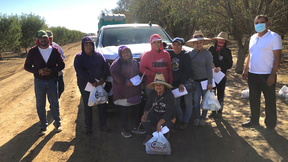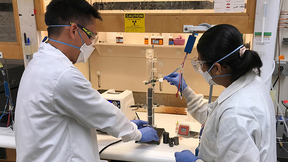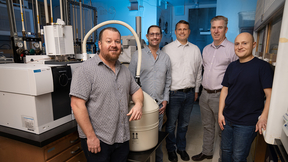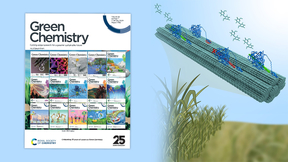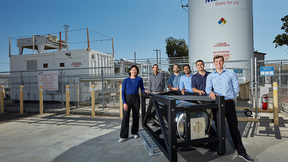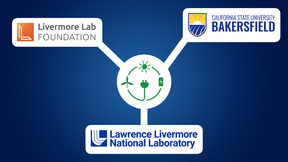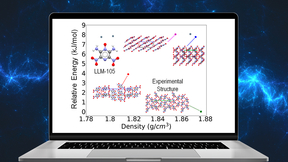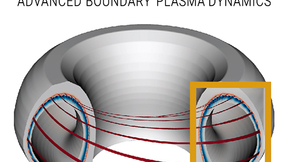Back
When materials are subjected to extreme environments, they face the risk of mixing together. This mixing may result in hydrodynamic instabilities, yielding undesirable side effects. Such instabilities present a grand challenge across multiple disciplines, especially in astrophysics, combustion and shaped charges — a device used to focus the energy of a detonating explosive…
Three new systems currently or soon-to-be sited at Lawrence Livermore National Laboratory (LLNL) on Monday debuted on the latest Top500 list of most powerful supercomputers in the world, including the first portion of the exascale machine El Capitan. Unveiled at the International Supercomputing Conference in Hamburg, Germany, the June 2024 Top500 lists three systems with…
Lawrence Livermore National Laboratory (LLNL) scientist and head of the Lab’s Carbon Initiative Jennifer Pett-Ridge has been selected as a fellow of the Ecological Society of America (ESA). ESA designates fellows of the society for certain members who have made outstanding contributions to a wide range of fields served by ESA. Pett-Ridge was selected for her work in soil…
Lawrence Livermore National Laboratory (LLNL) will provide technical assistance to 30 disadvantaged communities in west Fresno County to provide a future in clean-energy projects, including carbon capture and storage. The project is part of the Department of Energy’s Local Energy Action Program (LEAP) that aims to facilitate sustained community-wide economic and…
Four Lawrence Livermore National Laboratory (LLNL) researchers have partnered with Los Angeles-based SoCalGas and Munich, Germany-based Electrochaea to develop an electrobioreactor to allow excess renewable electricity from wind and solar sources to be stored in chemical bonds as renewable natural gas. When renewable electricity supply exceeds demand, electric-utility…
Lawrence Livermore National Laboratory (LLNL) has received $1 million to explore technologies that stimulate hydrogen production from mineral deposits found in the subsurface, including developing our understanding of hydrogen-producing geochemical reactions and how to enhance or control the rate of hydrogen production. The use of hydrogen fuel to offset fossil fuel…
The Department of Energy’s (DOE) High Performance Computing for Energy Innovation (HPC4EI) initiative today announced over $5 million in new funding for 13 industry partnerships, including a project led at Lawrence Livermore National Laboratory to develop more efficient optical cables. The awards, which stem from DOE’s Office of Energy Efficiency and Renewable Energy’s …
TATB (1,3,5-triamino-2,4,6-trinitrobenzene) is an important explosive compound because of its extensive use in munitions and world-wide weapons systems. Despite its importance, researchers have been trying to understand its response to temperature extremes for the past 50 years. A Lawrence Livermore National Laboratory (LLNL) team has uncovered a new thermal decomposition…
A Lawrence Livermore National Laboratory (LLNL) scientist is part of a research team shedding new light on how to access the sugars locked up in plant materials in order to convert byproducts into new feedstocks for production of fuels, materials and chemicals. Converting grasses, weeds, wood and other plant residues into sustainable products normally produced using…
Lawrence Livermore National Laboratory (LLNL) and Verne, a San Francisco-based startup, have demonstrated a cryo-compressed hydrogen storage system of suitable scale for heavy-duty vehicles. This is the first time cryo-compressed hydrogen storage has been demonstrated at a scale large enough to be useful for semi trucks, a milestone in high-density hydrogen storage…
Lawrence Livermore National Laboratory (LLNL) researchers, along with scientists from more than a dozen institutions, have completed a first-of-its-kind high-resolution assessment of carbon dioxide (CO2) removal (CDR) in the United States. The report, “Roads to Removal: Options for Carbon Dioxide Removal in the United States,” charts a path for the United States to achieve…
The U.S. Department of Energy (DOE) has awarded a four-year, $16 million project to a multi-institutional team led by Lawrence Livermore National Laboratory (LLNL) to accelerate inertial fusion energy (IFE) science and technology. This effort will be carried out by the newly established IFE Science and Technology Accelerated Research for Fusion Innovation and Reactor…
In the 2000s, Lawrence Livermore National Laboratory (LLNL) engineer Steve Hunter was asked to work on the concept for an Inertial Fusion Energy (IFE) power plant, not because of any laser or electronics knowledge that he has, but due to his firearms expertise. He needed to figure out how to inject a stream of targets into the target chamber, so that a constant source of…
Lawrence Livermore National Laboratory (LLNL) scientists will lead and co-lead projects in support of the Department of Energy’s (DOE) new Energy Earthshot program. The Energy Earthshots Initiative calls for innovation and collaboration to tackle the toughest topics in energy-related research. In January, DOE announced Office of Science funding for the Energy Earthshot…
Lawrence Livermore National Laboratory (LLNL), California State University, Bakersfield (CSUB) and the Livermore Lab Foundation (LLF) have signed an agreement to collaborate on advanced and clean-energy technologies, research opportunities and community partnerships that have the potential to shape the future of energy in the state and bring high-quality jobs to the region…
Lawrence Livermore National Laboratory (LLNL) will partner with outside institutions to improve diversity in the STEM workforce and provide training to underrepresented students and researchers under a pair of projects recently funded by the Department of Energy. With support from DOE’s Funding for Accelerated, Inclusive Research (FAIR) initiative, LLNL will partner with…
Lawrence Livermore National Laboratory (LLNL) researchers have racked up another top-notch year for securing grants through the Department of Energy’s (DOE) Technology Commercialization Fund (TCF) program. Matt Garrett, who was named earlier this year to lead the Lab’s Innovation and Partnerships Office (IPO), noted that the Lab’s engagements with industry are crucial for…
New research by Lawrence Livermore National Laboratory researchers and collaborators from Carnegie Mellon University (CMU) demonstrates that crystal structure prediction is a useful tool for studying the various ways the molecules can pack together, also known as ubiquitous polymorphism, in energetic materials. The research also shows promise of becoming an integral part…
A Lawrence Livermore National Laboratory-led project aimed at using computing tools to improve understanding of fusion plasma dynamics was among 12 projects recently awarded funding by the Department of Energy (DOE) to accelerate fusion power plant development. The four-year, multi-institutional Advanced Boundary Plasma Dynamics (ABOUND) project will receive $9.25 million…
Scientists at Lawrence Livermore National Laboratory (LLNL) collaborated with University of California San Diego (UCSD) to design, assemble, and field a portable optical Thomson scattering diagnostic system for the Advanced Research Projects Agency-Energy (ARPA-E) — a Department of Energy agency which supports private companies that are developing new ways to generate,…




